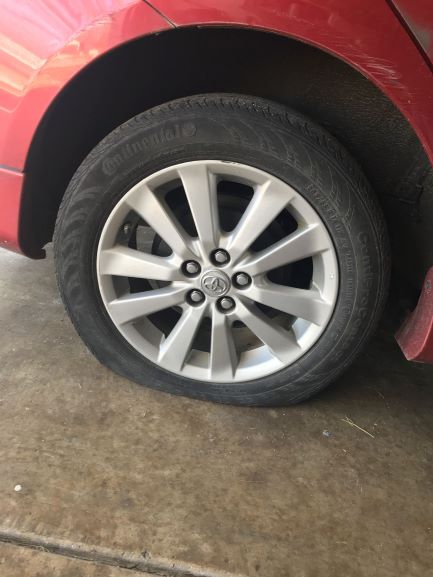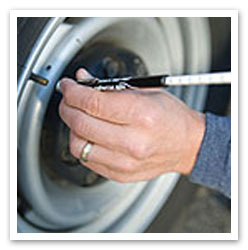How to Change a Tire
 Flat Tire
Flat Tire
A flat tire is never fun to deal with. We're here to provide information that will be helpful to you when it's time to replace your tires.
Which Type of Tire You Need
There are several types of tires to choose from:
- All-season tires: these tires will help you be prepared for normal driving conditions. You can use these in the snow or mud, but they won't perform quite as well in those conditions.
- Winter tires: if you drive in the snow frequently, winter tires will be a big help. These tires are much more effective in the snow than other tires.
- Summer tires: these tires won't work in conditions that are very cold or below freezing, or on snow and ice. They're useful in areas with warm weather, usually over 40 degrees Fahrenheit. If you try to use summer tires in cold weather, you won't have enough traction to drive safely.
- All-terrain tires: you'll find these tires on off-roading and other four-wheel drive vehicles. They can do pretty well on-road as well as off-road.
Most vehicles come with all-season tires. It's perfectly fine to keep these on your vehicle, but if you drive in the snow quite a bit, you may want to consider winter tires, also known as snow tires. You'll get much better traction on snow and ice with winter tires than with all-season tires. You shouldn't keep winter tires on your vehicle year-round, though, because as the weather warms up, they don't perform as well as all-season or summer tires.
Whichever tire you choose, make sure they are the correct size for your vehicle!
How to Replace a Tire
When it's time to replace a tire, you can either take it in to a professional, or do it yourself. If you do it yourself, you will need: a jack, a wrench, and a spare tire or your new tire. It's also helpful to have a heavy object such as bricks to place in front of your tires so that your vehicle doesn't roll away. Follow these steps to replace your tire:
- Put your vehicle in a safe, level, and stable place. You don't want your car to roll away! If you're changing your tire near the roadway, keep as far away from traffic as you possibly can and turn on your hazard lights to warn other drivers that you're stopped. Apply your parking brake and make sure you're in "Park."
- Locate your spare tire, wrench, and the jack and take them out of your vehicle. Use your wrench to loosen the lug nuts, turning the wrench counterclockwise. You'll want each lug nut to be loose enough that you can remove it by hand, but not so loose that the tire becomes unattached.
- Use your jack to lift your vehicle off the ground. Check your owner's manual to find the best place to put your jack. If your vehicle has a plastic molding, you don't want to place the jack anywhere that it will come in contact with the plastic molding. Most vehicles have a small notch near the wheel wells where the jack can be placed. Lift your vehicle off the ground once the jack is secure.
- Finish removing the lug nuts. Keep them together in a place where you won't drop or lose them. Grab your tire with both hands and carefully pull it towards you to remove it from your vehicle. It may be a little difficult to remove. You can try hitting it with your spare tire to help loosen it.
- Place your spare tire on the wheelbase. Make sure the holes in the spare tire line up with the lug nut posts. Push the spare into place on the wheelbase.
- Put the lug nuts on your spare tire so that it stays in place. Do not tighten the lug nuts with your wrench. Just turn them with your hands until the spare tire stays where it should be. Lower your vehicle back onto the ground so that the spare tire is lightly touching the ground, but not fully resting on it.
- Now you can start tightening the lug nuts with your wrench. You must tighten them in the correct pattern so that the tire goes on straight. Do this by tightening the lug nuts in a star pattern. In a star pattern around the tire, tighten each lug nut across from one another until they're equally tight.
- Finish lowering your vehicle to the ground. Check the lug nuts again using the star pattern to ensure they are tightened enough until they no longer budge.
If you used a spare tire, take your old tire to a mechanic to see if it can be patched up, or if you need to replace it completely. You shouldn't drive more than about 50 miles on a spare tire.
What to do if You Experience a Blowout
If you experience a tire blowout while you're on the road, don't immediately slam on your brakes. Instead, hold the steering wheel firmly and keep the car going straight. Slow down gradually by taking your foot off the gas pedal, but do not apply the brakes. When your car has slowed down, pull off the road to a safe place and apply the brakes when the car is almost stopped.
If your car starts to skid, it is very important not to slam on the brakes. Instead, take your foot off the gas pedal and the brake pedal. Don’t panic. You don’t want to mistakenly make a fast turn from the direction of the skid or steer too much, causing a spin. Instead, turn your steering wheel in the direction of the skid and then straighten the wheels.
If your vehicle has an anti-lock brake system (ABS), keep your foot on the brake pedal, maintaining firm and continuous pressure, while steering normally. Don’t pump the brakes. Don’t be frightened if you hear a mechanical sound or noise, and feel vibration or increased resistance in the brake pedal; that means your ABS is working. If you can, try to stop in a safe place off the road, then call for assistance.
How to Help Prevent Flat Tires
 Checking Tires
Checking Tires
Luckily, there are some strategies to make sure you don't get a flat tire on the road.
1. Always check around your vehicle before you drive.
Always check around the vehicle as you approach it. If you park in a garage, open the garage door before your check around to help avoid surprises once you open that door. Look around the outside of your vehicle for sharp items on the ground, such as broken glass (from car windows, lights, etc.), nails or screws (these could easily be forgotten on the floor of your garage after a project), or other debris that could interfere with movement or puncture your tires.
2. Check your tire pressure.
Both overinflating and underinflating your tires can be dangerous. Improperly-inflated tires can reduce traction, increase the likelihood of skidding, reduce the handling characteristics of your vehicle, and lead to your tires wearing out too quickly.
It's pretty easy to check your tire pressure on your own at home. Buy an air gauge and keep it in your vehicle so it's always handy. Place the air gauge onto the valve stem on your tire, then adjust the gauge until you stop hearing the sound of air leaving your tire. The gauge will tell you what your current PSI is in that tire.
Check your vehicle's owner manual to find out the recommended PSI for your tires. You may have a sticker inside the driver's side door that shows the recommended PSI as well. The recommended PSI will often be different for front and rear tires. Be sure to check all four tires and your spare.
You should check the air pressure in your tires frequently. Check the pressure when the tires are cool, because air condenses as the temperature falls. If your tires are warm, the pressure may read higher than when the tires are cool.
3. Rotate your tires.
Rotating your tires helps your tires wear evenly and can prolong their life. Evenly-worn tires boost your fuel economy and improve your traction. During tire rotation, each tire is removed from your car and rotated to a different position on your vehicle. For example, your front right tire may be rotated to the left rear axle of your vehicle. Tire rotation should be done in intervals and according to the specifications of the manufacturer, which can be found in your owner's manual. However, a good rule of thumb is to rotate them every time you have your oil changed.
4. Replace your tires as needed.
Tires don't last forever. Over time, tires lose their treads, which help keep traction on the road. Poor tires, or tires without tread, are dangerous. Check your vehicle's owner manual for the recommended timetable for when you should replace your tires.
Check the condition of your tires regularly. Look for obvious signs of distress like tread wear, damage, or bars showing. Search for bald spots and cuffing (uneven wear on the inside or outside tread areas), as well as cuts, stones, metal fragments or other damage. Make sure your tires are safe and whole before you drive away on them.
Take an Online Course to Learn More
If you enjoyed this article and are interested in learning more about driving-related topics, you should check out our courses on www.safe2drive.com.
We offer courses in a variety of topics including Defensive Driving and Driver Education. In addition to teaching you how to be a safe driver, our courses can help you dismiss a ticket, get your driver license, or even get an insurance discount. We also have courses specifically tailored to mature drivers (i.e., drivers age 55 and older) for insurance discounts.